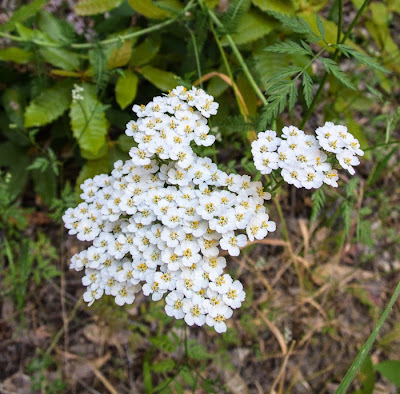Note: this post is edited as I had misidentified red twig dogwood as ninebark - I won't do that again! My thanks to an astute commenter (see below.)
So as I drive the creek-side road up towards our ridge-top road, I keep my eye open for seeding natives that might like to extend their reach by a mile or two to my restoration garden. I stopped to check and - POW!! I saw the white and yellow blossoms of Western Azalea (Rhododendron occidentale).
I've been keeping my eye on the Phacelia californica (I think that's the phacelia species) that grows along the road side.
 |
| Phacelia californica. Not the showiest of native perennials, but useful for wildlife and locally wild where I live. You can buy prettier ones like Tansy Leaf Phacelia (which is an annual). |
 |
| A shot showing the foliage for your ID-ing pleasure |
The stems and leaves are prickly-irritating so I don't want to put them where I'll be doing a lot of hand-weeding. I'd just like them to live wild and prosper in the wilder parts of the property.
I took four flower heads that had mostly gone to seed - though the fruiting bodies are a bit green still. I'm hoping some seeds will mature and dry in a paper bag. There are enough blooming plants that I think it's worth just a try. I'll wait before checking them again and try to learn their seed ripening time for future reference.
Because the inflorescence is a scorpioid raceme (yes I did have to look that up), new flowers bloom towards the unfurling end while flowers lower on the rachis (another term I had to look up) get on with turning into seeds.
And BTW this is the area where there is a nice reg twig dogwood (Cornus sericea) shrub, another shade lover. So far I've failed to make plants from cuttings - I have one still hanging on but I'm not hopeful. So I'm moving on to trying from seed.
 |
| Red twig dogwood (Cornus sericea) |
 |
| In bloom, red twig dogwood has round, creamy-white inflorescences. Here you can see unripe fruits. I'll keep checking and hope to make a note of when they ripen, for future reference. |
So - the western azalea story.
 |
| Western azalea (Rhododendron occidentale) growing right along the road-side river bank! I'll be checking these blossoms for seeds too, along with the dogwood and phacelia. |
Usually I've seen the western azalea in this creek only in inaccessible locations, deep in a poison-oak filled area. Here it was proffering nice soft- to semi-hard shoots, hanging out where the road maintenance hedge-trimmer tractor attachment would be sure to macerate them e'er long. They begged to be turned into cuttings and - hopefully - increase the western azalea population in our area.
So I took out my little folding scissors and neatly snipped off four low-growing shoots, about six or eight inches each, leaving narry a stub.
Back in the greenhouse, I made eight or nine cuttings and put them in my plastic greenhouse with other cuttings.
 |
| Western azalea cuttings |
I've set the mini-greenhouse up in a peculiar part of our bathroom where I hope cuttings will not get too hot or dry out too fast. The deck outside is shaded. (It's an owner-built house and has some oddities in the original construction that Wood Rat is putting to rights bit by bit!)
 |
| My latest attempt to grow cuttings in this mini-greenhouse in the bathroom! |
I have to confess I've not had terrific luck with cuttings lately, except for anything in the Ribes genus. If you fancy a go at growing from cuttings I can recommend Ribes as a slam dunk no matter how you do it!
 |
| A few miscellaneous cuttings - some Ribes, some Salvia - one dogwood, and four western azalea! |
So - wish me luck. If they do grow, and I get more than the one or two plants I think I can support with a bit of irrigation in the shadiest part of our property - I'll offer them to neighbors who have creeks on their properties. That would be fabulous. But - I'm not going to be too disappointed if it doesn't work. Just coming upon those lovely blooms was enough pleasure for me.
And oh here is another lovely bloom that was growing in that nice part of the road (which is otherwise slowly succumbing to invasive weeds, I'm very sorry to say).
 |
| A bit of yarrow, Achillea millefolium, growing nearby. |
Footnote: I always gather responsibly (very small percentage of seeds, minimal gathering of material for cuttings), and only very locally to my property - never in public parks or protected areas. I gather with permission on my neighbors' properties, and along verges of nearby county roads. I was told by a commenter a while back that gathering from roadsides is illegal (tell that to the berry pickers!!). I actually tried to get a ruling from local authorities on the legality of such gathering and they were not aware of any rules preventing me from doing so. Road maintenance crews routinely scalp these county roadsides so I feel absolutely no guilt about doing what I do!



Comments
A week after I wrote the post (and forgot that I had written about this plant!) I was at a nursery and saw - ninebark - with leaves much more like a golden currant, lobed as you say.
So now I'm put right and I do appreciate your comment. We all get cross-wired sometimes, and we all forget to check what we think we know - and I am certainly guilty of that! And I'll put in the correction and I'll never ever forget the difference again!